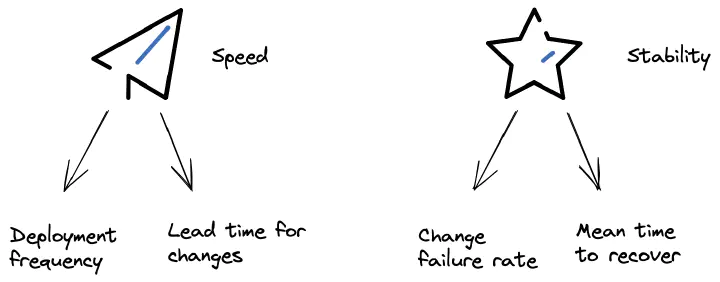There are many talks and articles that deal with the growing complexity of software and scaling software development teams. But often, it is hard to see a fundamental improvement apart from anecdotal stories. Rather, the question often remains: Does this really help?
The findings described by Forsgren, Humble & Kim in the book “Accelerate” 1 are quite different: Here, large-scale surveys were used to determine which characteristics correlate with high-performing software development teams and which do not.
This is exciting because they do not simply state “To achieve goal X, do A, B and/or C”, but because scientifically sound observations are described on the basis of large survey-based studies, from which one can draw important conclusions for modern software development.
The 4 key metrics of successful software development teams
In summary, the authors found that top performers among software development teams outperformed low performers by orders of magnitude in 4 key metrics (the following data refers to the corresponding study conducted in 2017):
Deploymenthäufigkeit: On average, top performers deploy 46 times more frequently
Lead time: The time between commit (feature is fully developed) and deploy (feature goes live into production) is on average 440 times faster
Mean time to recover: The time to restore a failed service after a failure is on average 170 times faster
Change failure rate: The percentage of deployments with serious errors was five times higher for low-performers than for top performers

Figure 1: The 4 key metrics of Accelerate
This shows that top performers manage to deliver software more often, faster and with higher quality.
This is why these four key metrics are so important when it comes to the initial evaluation of the situation in software development teams. Often, teams that are struggling with increasing complexity in software development, have their problems with at least one of the metrics and have significantly fallen behind top performers.
What can be learned from this
The four key metrics provide an initial starting point for assessing one’s own situation. Furthermore, the authors have identified 24 characteristics and skills that contribute significantly to an improved software development speed. We will present these in more detail in another article soon.
But what they have also discovered is that some measures – while having been widely used as a supposed recipe for success in recent years – do not correlate at all with improvements:
-
The age and technology used in the application
-
Whether deployments are performed by the development team or a dedicated operations team
-
Whether changes are approved by someone outside the team (Change Approval Board or similar) - here it is even the case that a more heavyweight process correlates directly negatively with performance!
More details can be found in the corresponding book “Accelerate: Building and Scaling High Performing Technology Organizations” 1.


